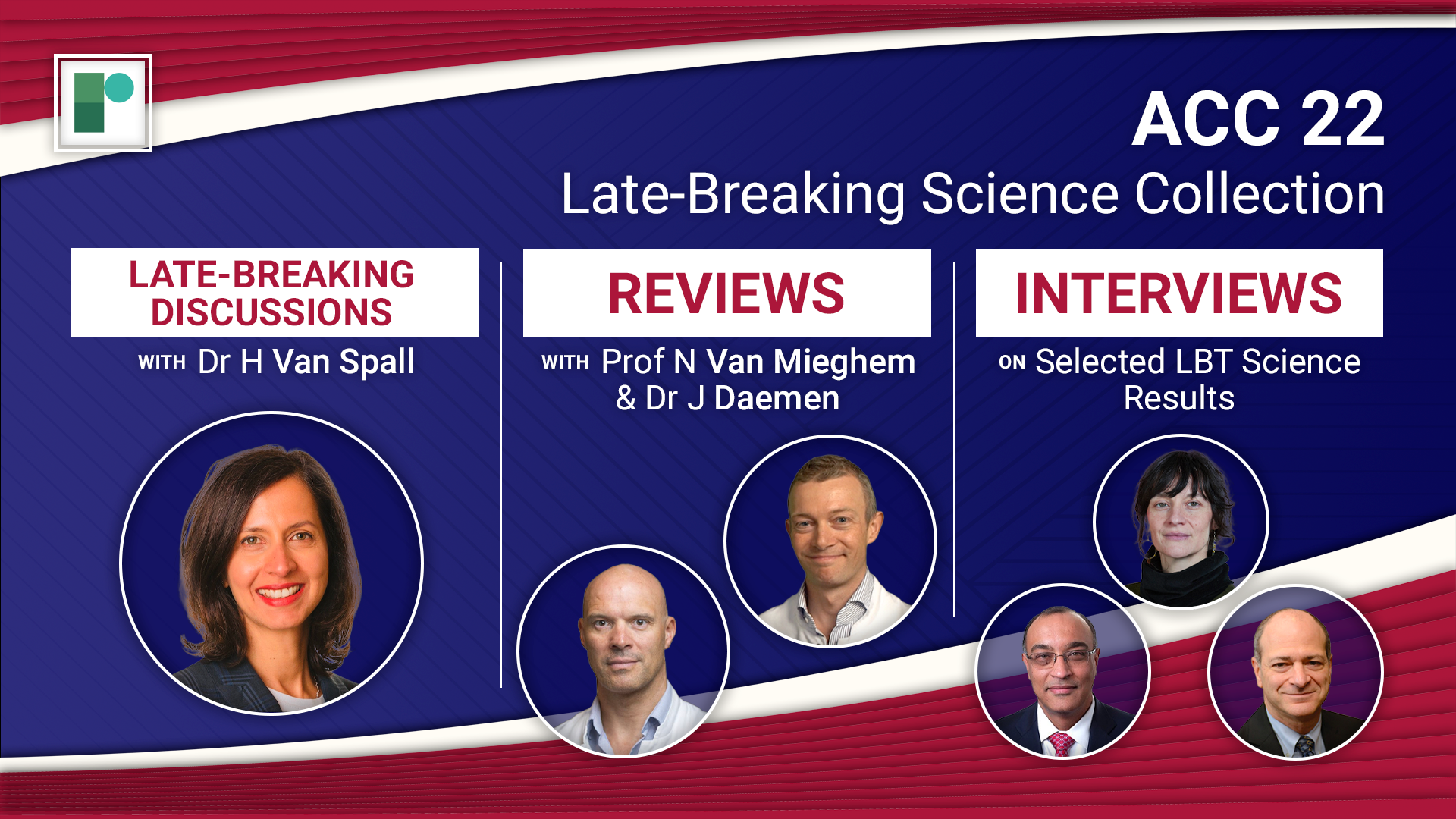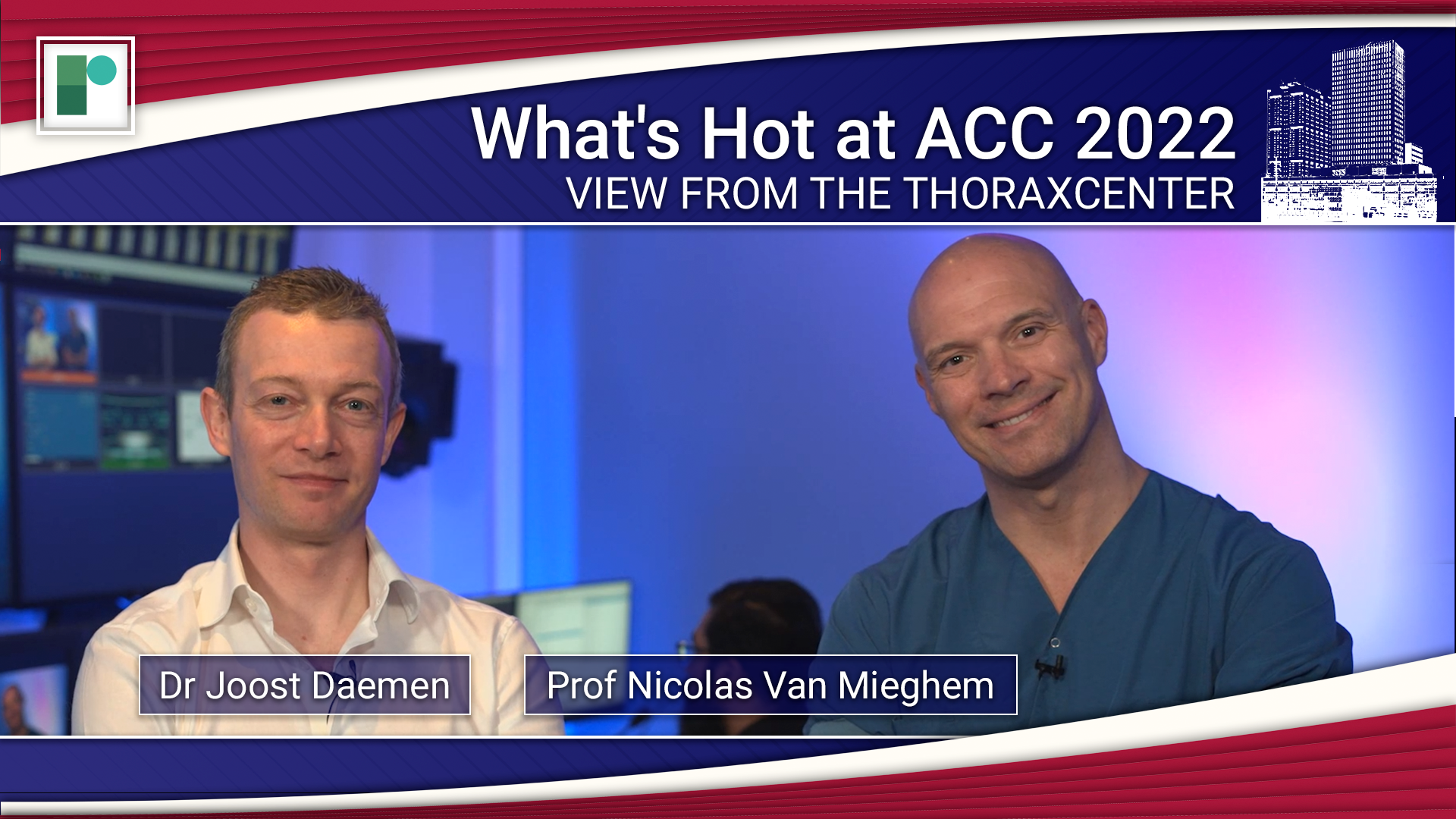ACC 2022: Late-breaking Science Video Collection
Published: 05 April 2022
-
Views:
 7838
7838
-
Likes:
 7
7
-
Views:
 7838
7838
-
Likes:
 7
7
-
 Up Next
Up Next -
 3m 19sPart 3 | Session 3 ACC 22: Results From the PACIFIC AF Trial
3m 19sPart 3 | Session 3 ACC 22: Results From the PACIFIC AF Trial -
 3m 6s
3m 6s -
 3m 54sPart 3 | Session 5 ACC 22: Results from the TRANSLATE-TIMI 70 Trial
3m 54sPart 3 | Session 5 ACC 22: Results from the TRANSLATE-TIMI 70 Trial -
 4m 22sPart 3 | Session 6 ACC 22: Results from the POISE-3 Trial
4m 22sPart 3 | Session 6 ACC 22: Results from the POISE-3 Trial -
 6m 30sPart 3 | Session 7 ACC 22: ICD Shock Therapies and the Burden of Ventricular Tachycardia
6m 30sPart 3 | Session 7 ACC 22: ICD Shock Therapies and the Burden of Ventricular Tachycardia -
 6m 3s
6m 3s -
 3m 31sPart 3 | Session 9 ACC 22: Magnitude & Duration of Effects of a siRNA Targeting Lp(a)
3m 31sPart 3 | Session 9 ACC 22: Magnitude & Duration of Effects of a siRNA Targeting Lp(a) -
 4m 48sPart 3 | Session 10 ACC 22: Results From a sub-study of the POISE-3 Trial
4m 48sPart 3 | Session 10 ACC 22: Results From a sub-study of the POISE-3 Trial -
 2m 55sPart 3 | Session 11 ACC 22: Findings from the CoreValve US Pivotal & SURTAVI Trials
2m 55sPart 3 | Session 11 ACC 22: Findings from the CoreValve US Pivotal & SURTAVI Trials -
 7m 44sPart 3 | Session 12 ACC 22: ADAPT-TAVR Shows SLT Does Not Affect CO for Patients After TAVR
7m 44sPart 3 | Session 12 ACC 22: ADAPT-TAVR Shows SLT Does Not Affect CO for Patients After TAVR -
 5m 41sPart 3 | Session 13 ACC 22: Results From the Chocolate-Touch Study
5m 41sPart 3 | Session 13 ACC 22: Results From the Chocolate-Touch Study -
 2m 25sPart 3 | Session 14 ACC 22: Results from the GIPS-IV Trial
2m 25sPart 3 | Session 14 ACC 22: Results from the GIPS-IV Trial -
 9m 27s
9m 27s -
 5m 35s
5m 35s -
 10m 24s
10m 24s -
 3m 50sPart 3 | Session 18 ACC 22: 3-year Efficacy Outcomes from the SPYRAL HTN-ON MED Med Pilot Study
3m 50sPart 3 | Session 18 ACC 22: 3-year Efficacy Outcomes from the SPYRAL HTN-ON MED Med Pilot Study -
 4mPart 3 | Session 19 2022 AHA/ACC/HFSA Guideline for HF Management: Highlights & Implementation
4mPart 3 | Session 19 2022 AHA/ACC/HFSA Guideline for HF Management: Highlights & Implementation
-
 12m 6sPart 4 | Session 1 ACC 22: 3 Trials That Will Change Your Practice with Dr Purvi Parwani
12m 6sPart 4 | Session 1 ACC 22: 3 Trials That Will Change Your Practice with Dr Purvi Parwani -
 6m 15s
6m 15s -
 7m 9sPart 4 | Session 3 4 Lipid Late-breaker Highlights from ACC.22 with Dr Erin Michos
7m 9sPart 4 | Session 3 4 Lipid Late-breaker Highlights from ACC.22 with Dr Erin Michos
-
 23m 9sPart 1 | Session 1 ACC 22 Late-breaking Science Preview Nicolas M Van Mieghem, Joost Daemen
23m 9sPart 1 | Session 1 ACC 22 Late-breaking Science Preview Nicolas M Van Mieghem, Joost Daemen
-
 28m 6sPart 1 | Session 2 ACC.22 Late-breaking Science Wrap-Up Nicolas M Van Mieghem, Joost Daemen
28m 6sPart 1 | Session 2 ACC.22 Late-breaking Science Wrap-Up Nicolas M Van Mieghem, Joost Daemen
-
 16m 42sPart 2 | Session 1 ACC 2022 Late-breaker Discussion: The SODIUM-HF Trial Justin Ezekowitz, Harriette Van Spall
16m 42sPart 2 | Session 1 ACC 2022 Late-breaker Discussion: The SODIUM-HF Trial Justin Ezekowitz, Harriette Van Spall
-
 16m 57sPart 2 | Session 2 ACC 2022 Late-breaker Discussion: The SuperWIN Trial Harriette Van Spall, Dylan L Steen
16m 57sPart 2 | Session 2 ACC 2022 Late-breaker Discussion: The SuperWIN Trial Harriette Van Spall, Dylan L Steen
-
 15m 38sPart 2 | Session 3 ACC 22 Late-breaker Discussion: The PROMPT-HF Trial Harriette Van Spall, Gregg C Fonarow, Tariq Ahmad
15m 38sPart 2 | Session 3 ACC 22 Late-breaker Discussion: The PROMPT-HF Trial Harriette Van Spall, Gregg C Fonarow, Tariq Ahmad
-
 22m 47sPart 2 | Session 4 ACC 22 Late-breaker Discussion: The DIAMOND Trial Harriette Van Spall, Javed Butler, Faiez Zannad
22m 47sPart 2 | Session 4 ACC 22 Late-breaker Discussion: The DIAMOND Trial Harriette Van Spall, Javed Butler, Faiez Zannad
-
 9m 38sPart 3 | Session 1 ACC 22: Findings from the VALOR-HCM Trial Milind Y Desai
9m 38sPart 3 | Session 1 ACC 22: Findings from the VALOR-HCM Trial Milind Y Desai
Overview
Our regular review series View from the Thoraxcenter hosted by Prof Nicolas Van Mieghem and Dr Joost Daemen (Thoraxcentre, Erasmus MC, Rotterdam, NL) provide a concise analysis of the late-breaking science results and spotlight impactful data.
For a deeper dive into key clinical trial data, Dr Harriette Van Spall (McMaster University, Hamilton, CA)talks with principal investigators in her regular Late-Breaker Discussion Series.
Short, accessible Expert Interviews were conducted with select faculty focusing on the results, applicability, and impact on future research.
More from this programme
Part 1
View from the Thoraxcenter
Part 2
Late-breaker Discussion Series
Part 3
Expert Interviews
Faculty Biographies

Florian Rader
Director
Dr Florian Rader is the medical director of the hypertension center at Cedars-Sinai Heart Institute in Los Angeles, California. His clinical research focuses on hypertrophic cardiomyopathy and hypertensive patients.
Transcript
Importance of this study
Yeah, I think the backdrop of this study is that since investigators started to unravel the disease of hypertrophic cardiomyopathy, now over more than 60 years ago, there really hasn't been any specifically designed treatment for this disorder. So mavacamten is probably one of the most promising candidates for this role. In addition, it's important to notice that many patients with obstructive hypertrophic cardiomyopathy have significant symptoms and these symptoms are only partially relieved right now with medications. And many of those have to go on to invasive procedures to relieve the obstruction.
Study design and patient cohort
So the MAVA-LTE study is a long term open label extension of the previous pivotal trial of mavacamten, the EXPLORER-HCM trial for patients with obstructive hypertrophic cardiomyopathy. Those patients who finished the EXPLORER-HCM trial were weaned off mavacemten, and then re-enrolled into the long-term extension study. This is a study we're looking at right now. So this is an ongoing dose-blinded but otherwise open label trial of all patients who previously participated in EXPLORER-HCM. So patients in the MAVA-LTE long-term extension trial will be enrolled or followed for up to 252 weeks. What we're looking at here at this interim analysis is interim outcomes of these patients at a medium follow-up duration of 63 weeks.
Key findings
Yeah, the key findings here are that very similarly to the results in the parent study, EXPLORER-HCM, we found significant reductions in left ventricular outflow tract gradients. So a relief of the obstructive portion of this disorder. We also saw an expected decrease in ejection fraction by about 7 to 9% during follow up. And this is expected because the mechanism of mavacamten does reduce the force of contraction and that's how the obstruction is being relieved. And importantly, I think we also saw that along with very dramatic reductions in NTproBNP levels, sort of a marker of heart failure, improvement status also improved or a functional class, New York Heart Association functional class improved significantly. So specifically there were at week 48, 67.5% who improved at least one New York Heart Association class of shortness of breath.
Considerations for use
So based on these results. So we already know from the EXPLORER-HCM trial that mavacamten is effective for relieving LVT gradients improving functional class and symptom status in patients with obstructive hypertrophic cardiomyopathy. Now we sort of also have learned that longer term extension of the use of this medication is just as effective. And importantly, we now have more follow up data. So we also learned more about the safety of this medication. Overall, the safety profile of this medication was very good. There were of course, a large amount of adverse events recorded during the study. That's how we learn about potential risks of new medications but overall there were no new safety signals in terms of new concerns that would make us require more intense surveillance of echo follow up or pharmacodynamic data that we already knew after EXPLORER-HCM.
Take-home messages
So I think the take-home messages are that mavacamten continues to be the most promising contender for a first specifically designed medication or drug therapy for obstructive hypertrophic cardiomyopathy. And it seems to be extremely effective when it comes to relief of the obstructive portion of hypertrophic cardiomyopathy. It seems to be extremely effective in reducing BMP levels, along with improvements in New York Heart Association Functional class status and another important take home message is that the medication seems to be safe and overall very well tolerated and reductions in injection fraction that only very rarely exceed the level of 50% are in almost all instances reversible. So this medication does seem to be very safe and very useful for clinical practice.
Further research required
I think regulators will continue to look at the outcomes and further interim analysis of this long term extension trial. Like I said, this trial will go on for a total of over 250 weeks. So as we go along, we might learn more about additional ways to manage these patients. We will learn more about the durability of the medication and we will also learn more about the long term safety of this medication and therefore the usefulness in clinical practice. It also will inform, I think the question of how frequently do we have to check echocardiograms for example, to make sure that ejection fraction stays in an optimal range. So I think this will be very important for treating physicians and practitioners but also for regulatory bodies.





